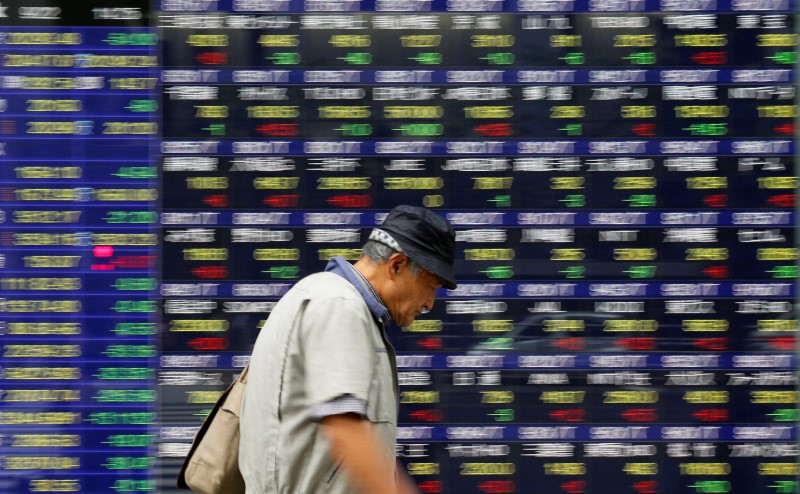
A man walks past an electronic stock quotation board outside a brokerage in Tokyo, Japan, September 22, 2017. REUTERS/Toru Hanai – RC16074E2450
January 31, 2018
By Marc Jones
LONDON (Reuters) – World stocks pulled out of a two-day dive and were eyeing their second best start to a year ever on Wednesday, while the dollar came under renewed pressure ahead of the Federal Reserve’s first meeting of the year.
A controversy-free State of the Union address from U.S. President Donald Trump had helped Asian bourses steady as bond markets also calmed after another round of selling had left U.S. Treasury yields at 4-year highs.
Europe’s pan-regional STOXX 600 and Wall Street futures then followed with modest 0.1 and 0.3 percent gains [.EU] to bolster the 5.6 percent jump MSCI’s 47-country ACWI index has made this month.
That puts it neck-and-neck with 2012’s fast start, after which only 1994’s 6.5 percent leap would be better.
“We can interpret the remarkable January performance as a spill over from 2017 – growth gathering pace, low inflation and low volatility, and that has accelerated the momentum,” said ABN Amro’s Chief Investment Officer Didier Duret.
“For me this is a prelude to the year where the equity market trend is not broken… there will be phases of people coming into the market and then correction phases as volatility spikes.”
A market gauge of that volatility – the VIX – perked up to its highest levels since August 2017 and has nearly doubled this month.
One of the big boosts for stocks though, especially in emerging markets which have seen the biggest gains, has been the weakness of the dollar.
It fell by a quarter of a percent again on Wednesday against a basket of other top currencies on course for its biggest monthly drop at 3.5 percent in nearly two years. [FRX/]
The day’s most eye-catching move was a 2-1/2 year low against China’s yuan of 6.3287. It has been the greenback’s heaviest monthly drop against the Chinese currency since 1994 having lost more that 3 percent.
Other Asian action saw the yen briefly slip when the Bank of Japan upped its medium-term Japanese government bond buys (JGBs) in a move seen as a warning shot against further rises in its bond yields and currency.
The dollar later pared its gains however and was last trading at 108.82 yen as it also backed off to $1.2445 to the euro and $1.4165 to the pound respectively.
In the opening weeks of 2018, Europe recorded the highest equity inflows across all major regions, adding to a strong 2017 which saw the region cornering over one-third of all global equity fund flows.
FED AHEAD
All eyes will be on the outcome of the Federal Reserve’s first meeting of the year later which will also be Janet Yellen’s last in charge.
With U.S. growth humming and unemployment at a 17-year low rates markets are currently pricing in a little over 80 percent chance of another Fed rate hike in March and between two and three for the year as a whole.
The Fed is due to release its policy statement at 2 p.m. EST (1900 GMT) but there won’t be a news conference or new forecasts this month.
“In light of the steady stream of favorable data, it is possible that the FOMC’s (Fed’s) statement upgrades language on activity somewhat, which could be viewed as a marginally hawkish shift,” analysts at BNP Paribas said in a note.
There was the earnings treadmill too. U.S. Health insurer Anthem reported a higher-than-expected quarterly profits ahead of the Wall Street opening bell though there had been some shockers in Europe.
British outsourcing group Capita lost 40 percent of its value after its new boss slashed profit forecasts and set out plans to raise cash to avoid the same fate as recently-collapsed builder Carillion.
Poor results also sent telecoms equipment maker Ericsson tumbling over eight percent at one point and there were more woes for fashion retailer H&M as it said it would open far fewer stores in 2018 following a profits hit. [.EU]
Bond markets meanwhile were quiet but heading for their biggest monthly sell-off since late 2016, a sign that the tide for bonds has turned as a stronger world economy spells the end for ultra-easy monetary policies.
U.S. 10-year Treasury yields, hovered at just above 2.7 percent, having risen almost 30 bps this month. Those on German Bunds – Europe’s benchmark are up 25 basis points and at 0.68 percent on Wednesday.
“Monetary policy looks very inconsistent with the level of growth and inflation,” said Anujeet Sareen, a portfolio manager at Brandywine Global. “Given the normalization process, the whole bond market looks like it’s just not high enough in terms of yields.”
Such major swings in the dollar and bond markets have been replicated in commodity markets too.
Oil fell for a third day, but remained on track for its biggest gain in January in five years, in spite of data that showed U.S. crude stocks rose more than expected last week.
Brent crude, the global benchmark, was down 40 cents at $68.63 a barrel having started the year at just over $66 a barrel. It will be its fifth straight month of gains.
(Additional reporting by Dhara Ranasinghe in London; Editing by Raissa Kasolowsky,William Maclean)

